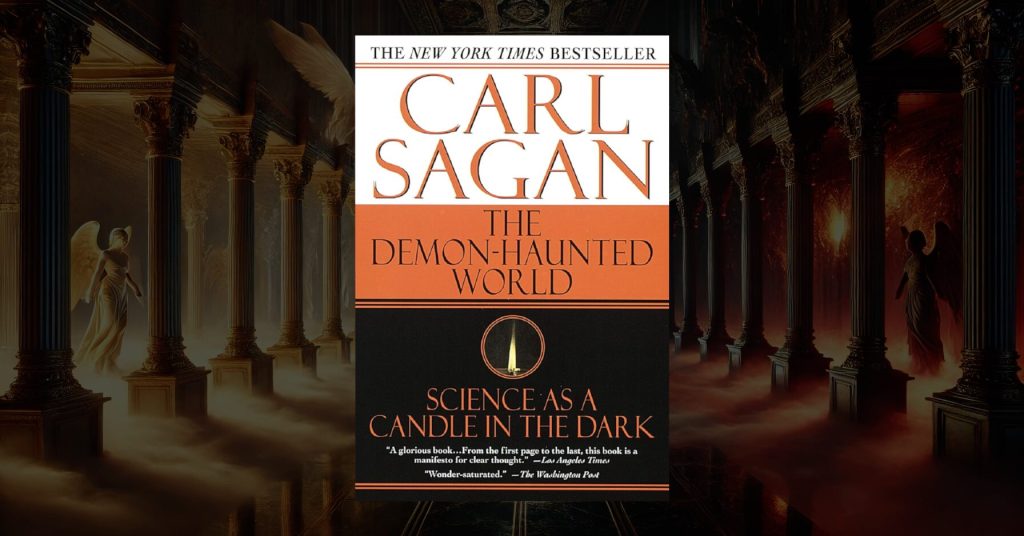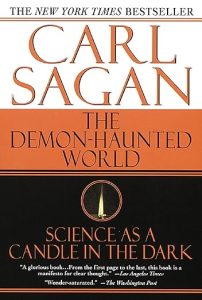
Welcome to my monthly book recommendation for March! Every month, I recommend a book that I’ve personally read and find worthwhile enough to recommend to my own readers. In each post, I’ll introduce the book, discuss why I found reading it worthwhile, and the major themes the book touches upon. I won’t include any major spoilers, but I may discuss some of the characters and specific details or locations from within the book.
My recommendation for March 2025 is Carl Sagan’s The Demon-Haunted World.
The Demon-Haunted World: Science as a Candle in the Dark
Available on Amazon
 Authors: Carl Sagan, Ann Druyan
Authors: Carl Sagan, Ann Druyan
Genre: Non-fiction
Description:
How can we make intelligent decisions about our increasingly technology-driven lives if we don’t understand the difference between the myths of pseudoscience, New Age thinking, and fundamentalist zealotry and the testable hypotheses of science?
Casting a wide net through history and culture, Pulitzer Prize–winning author and distinguished astronomer Carl Sagan argues that scientific thinking is critical not only to the pursuit of truth but to the very well-being of our democratic institutions. He examines and authoritatively debunks such celebrated fallacies as witchcraft, faith healings, demons, and UFOs. And yet, disturbingly, in today’s so-called information age, pseudoscience is burgeoning, with stories of alien abduction, “channeling” past lives, and communal hallucinations commanding growing attention and respect.
As Sagan demonstrates with lucid eloquence, the siren song of unreason is not just a cultural wrong turn but a dangerous plunge into darkness that threatens our most basic freedoms.
My Thoughts
Demon-Haunted World opens with a survey of the widespread phenomenon of alien UFO sightings during the 90s and the decades preceding. This has persisted somewhat – even during my childhood in the early 2000s, I recall numerous interviews, documentaries, and local rumors of UFO sightings, and the general perception that, as crazy as it sounds, there just might be something to it. Sagan begins to offer cursory explanations for its impact on society, encroaching on some of the basic pseudoscience and mysticism at play without spoiling any of the major contents of the book to come.
As soon as we’ve enveloped ourselves in the modern fanaticism of UFO sightings, we’re taken back hundreds of years to a fascinating historical study of demons amidst societies vastly different from our own. The transition may seem jarring at first, but as we learn about the societies in question and their relationship to demons, God, and the supernatural, things start to click for demons and UFOs alike. Everything makes sense once that initial hurdle is crossed. This mass delusional belief in UFOs isn’t the first time we’ve seen such a phenomenon in our history – there are many parallels across societies throughout the ages.
After thorough discussions on the psychology that fuels pseudoscience, beliefs that are driven by pseudoscience, and hoaxes that fuel pseudoscience even after their unveiling, Sagan introduces his “baloney-detection kit,” what is essentially a list of questions one should ask themselves when they’re met with magnitudinous claims, especially those that challenge conventional wisdom. This “kit” encompasses many of the pillars of modern rationality: verifiability, falsifiability, exploration of hypotheses, objectivity, and Occam’s razor, amongst others. He then introduces another list, one of pitfalls to avoid, including items such as arguments from authority, ad hominem arguments, appeals to ignorance, and more. Generally, I find such lists to be useless, as people will typically breeze over its bullet points and move on, never to revisit the list or consider its contents again. However, in this case, I believe Sagan laid significant groundwork prior to the introduction of these lists, allowing readers to contextualize each point immediately upon reading, and he continues to provide further context throughout the remainder of the book. As far as lists go, these are among the most effective.
Sagan has done an exemplary job of tailoring this book to a wide audience. Despite being a rational, science-based book, Sagan ensures that little to no prior scientific knowledge is needed to grasp the concepts. I believe Sagan took extra precautions to ensure he presents everything as gently as possible so that those who are especially susceptible to pseudoscience and fanaticism are gently guided through without being offput or offended.
Sagan does recognize the pitfalls of science itself and the scientists who pursue it, citing cases where their work has directly contributed to prejudices and loss of life. No human is perfect, however rational, science-minded, or skeptical they may be. This expresses the belief that there is no perfect solution, not even those of critical thinking, scientific inquiry, and rationality. It isn’t a matter of replacing one belief system with another, it’s replacing dogmatic systems that proport to have all the answers with functional systems that proport only to describe what is within their descriptive power.
This month’s recommendation is unique insofar that this book is one I’d recommend to a global audience. Both the intended and effective target audiences of all other books I’ve recommended are not entirely universal – they all cater to specific genres or demographics, even if those groups are broad in and of themselves. This book, however, is not only suitable for the general audience, I’d consider it essential reading for the general audience. Even though this book was written in the 90s, it fully applies to the world we live in today, and I suspect, for centuries to come.
I’d like to close things out with a quote from this book, one which I’ve seen rapidly spreading across social media in recent days:
“I have a foreboding of an America in my children’s or grandchildren’s time — when the United States is a service and information economy; when nearly all the manufacturing industries have slipped away to other countries; when awesome technological powers are in the hands of a very few, and no one representing the public interest can even grasp the issues; when the people have lost the ability to set their own agendas or knowledgeably question those in authority; when, clutching our crystals and nervously consulting our horoscopes, our critical faculties in decline, unable to distinguish between what feels good and what’s true, we slide, almost without noticing, back into superstition and darkness…
The dumbing down of American is most evident in the slow decay of substantive content in the enormously influential media, the 30 second sound bites (now down to 10 seconds or less), lowest common denominator programming, credulous presentations on pseudoscience and superstition, but especially a kind of celebration of ignorance”